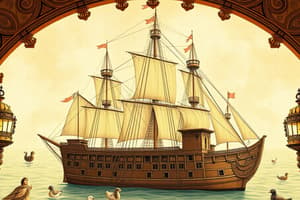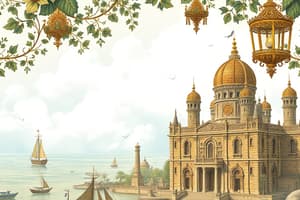Podcast
Questions and Answers
What was the primary motivation for Europeans to find new trade routes to Asia before 1492?
What was the primary motivation for Europeans to find new trade routes to Asia before 1492?
- To avoid the costly Arab and Turkish middlemen controlling traditional land routes. (correct)
- To establish colonies and expand their empires.
- To spread Christianity to new lands.
- To discover new sources of gold and silver.
How did the Spanish encomienda system impact the Taino population in Hispaniola?
How did the Spanish encomienda system impact the Taino population in Hispaniola?
- It subjected them to forced labor and harsh treatment, leading to a drastic decline in population. (correct)
- It led to their protection and conversion to Christianity, ensuring their survival.
- It encouraged the development of sustainable agriculture and economic prosperity.
- It facilitated fair trade and cultural exchange, improving their living standards.
What role did Prince Henry of Portugal play in the age of exploration?
What role did Prince Henry of Portugal play in the age of exploration?
- He discovered the Cape of Good Hope.
- He led the conquest of the Aztec and Inca empires.
- He financed Christopher Columbus's voyages to the Americas.
- He sponsored voyages and helped conquer Ceuta, a city in North Africa. (correct)
How did the end of feudalism alter European society and enable exploration?
How did the end of feudalism alter European society and enable exploration?
What was the significance of Bartolomeu Dias's voyage in 1487?
What was the significance of Bartolomeu Dias's voyage in 1487?
What was the primary purpose of feitorias established by the Portuguese?
What was the primary purpose of feitorias established by the Portuguese?
Why did the Spanish monarchs initially hesitate to support Columbus's voyage?
Why did the Spanish monarchs initially hesitate to support Columbus's voyage?
What factors contributed to the Tainos' welcoming attitude toward the Spaniards upon their arrival?
What factors contributed to the Tainos' welcoming attitude toward the Spaniards upon their arrival?
What was the significance of Vasco da Gama's voyage in 1498?
What was the significance of Vasco da Gama's voyage in 1498?
How did the Spanish view the Native Americans upon encountering them?
How did the Spanish view the Native Americans upon encountering them?
What fundamental difference in values existed between the Spanish and the Taino societies?
What fundamental difference in values existed between the Spanish and the Taino societies?
What was the long-term impact of Spanish actions in Hispaniola on the island's population?
What was the long-term impact of Spanish actions in Hispaniola on the island's population?
How did the Renaissance influence exploration and trade?
How did the Renaissance influence exploration and trade?
What did Antonio de Montesinos do that was significant?
What did Antonio de Montesinos do that was significant?
Prior to the Renaissance, from where did Europe borrow ideas and technologies?
Prior to the Renaissance, from where did Europe borrow ideas and technologies?
Which of the following best describes the hybridity found in Latin America?
Which of the following best describes the hybridity found in Latin America?
How did the fall of Constantinople in 1453 contribute to European exploration?
How did the fall of Constantinople in 1453 contribute to European exploration?
In the context of the Age of Exploration, what does syncretism refer to?
In the context of the Age of Exploration, what does syncretism refer to?
How does Latin American art reflect cultural hybridity?
How does Latin American art reflect cultural hybridity?
What was the effect of Gutenberg's Printing Press?
What was the effect of Gutenberg's Printing Press?
Flashcards
Land (Fief)
Land (Fief)
The social system in the Middle Ages centered on land ownership.
Feudalism
Feudalism
A system where society is structured around relationships derived from the holding of land in exchange for service or labor.
Gutenberg's Printing Press
Gutenberg's Printing Press
Invented in 1455, it revolutionized information and contributed to the Renaissance.
Feitorias
Feitorias
Signup and view all the flashcards
Bartolomeu Dias
Bartolomeu Dias
Signup and view all the flashcards
Vasco da Gama
Vasco da Gama
Signup and view all the flashcards
Columbus's ships
Columbus's ships
Signup and view all the flashcards
Syncretism
Syncretism
Signup and view all the flashcards
Hybridity
Hybridity
Signup and view all the flashcards
Guanahani
Guanahani
Signup and view all the flashcards
Columbus's Landing Date
Columbus's Landing Date
Signup and view all the flashcards
Granada (1492)
Granada (1492)
Signup and view all the flashcards
HISPANIOLA
HISPANIOLA
Signup and view all the flashcards
LATIN AMERICA
LATIN AMERICA
Signup and view all the flashcards
Columbus' idea
Columbus' idea
Signup and view all the flashcards
Encomienda
Encomienda
Signup and view all the flashcards
Religious Syncretism
Religious Syncretism
Signup and view all the flashcards
Study Notes
- The Middle Ages were characterized by limited individual thought and freedom due to religious control and feudalism.
- Exploration began to increase as these limitations started to change.
- Land (Fief) was central to the feudal system of the Middle Ages.
- The Gutenberg Printing Press was invented in 1455.
- Prince Henry of Portugal helped conquer Ceuta in North Africa.
- Feitorias were trading posts protected by soldiers, where gold, ivory, and slaves were traded directly with African people.
- In 1487, Bartolomeu Dias reached the southern tip of Africa, known as the Cape of Good Hope.
- In 1498, Vasco da Gama became the first European to reach India by sailing around Africa.
- The three ships used by Columbus named the Pinta, the Niña, and the Santa Maria.
- Syncretism is the mixing of different religions and beliefs.
- Hybridity is the blending of different cultural traditions.
- Guanahani, the first island Columbus reach is known as San Salvador today.
- On October 12, 1492, Columbus landed in America.
- In 1492, Isabella the Catholic defeated the Emir of Granada and conquered the city.
- Hispaniola is also known as La Española.
- Latin America includes all countries in the Americas that speak languages derived from Latin.
- These languages are Spagnish, French, and Portuguese.
- Spanish America includes the Spanish-speaking countries in the Americas.
- A new rich trading class called the bourgeoisie challenged the old feudal system.
- After the fall of Constantinople to the Ottoman Turks in 1453, traditional land routes to Asia became too costly due to Arab and Turkish middlemen.
- Before the Renaissance, knowledge was borrowed from the Middle East or China.
- During the Renaissance, Europe advanced in science, printing, and sailing, helping countries explore the world for better trade routes to Asia.
- Prior to 1492, Europe was not the center of the world.
- Europeans risked sailing around Africa to reach Asia to avoid expensive middlemen, despite beliefs about the Equator being deadly.
- Christopher Columbus was born in Genoa and started sailing at a young age.
- In 1476, Columbus swam 8 km to shore after his ship sank near Portugal and stayed there for 9 years.
- Columbus stayed in Portugal, married Filipa, had a son, Diego, and conceived the idea of sailing west to reach Asia.
- Columbus sought advice from Paolo Toscanelli, who supported the idea of sailing west and provided an estimated distance.
- Columbus left Portugal after being rejected and sought support from Queen Isabella of Spain in 1486.
- The queen did not immediately agree, delaying her decision for six years.
- The Queen's scientists doubted the plan, and they were right as Columbus underestimated the distance.
- The Spanish kings were fighting a war against the Arabs in Granada.
- Columbus sought 10% of future trade profits; to build feitorias.
- In 1492, the Spanish kings agreed to support Columbus, who gathered 90 sailors and 3 ships to sail to Asia.
- On August 3rd, 1492, Columbus set sail from Palos de la Frontera, stopping at the Canary Islands and discovered Cuba and Hispaniola.
- Columbus established the first colonial government in America.
- The Tainos, Native Americans in the Caribbean, were farmers who grew taro and yams, and used irrigation systems.
- The Tainos lacked written records; the knowledge about them is derived from their cultural practices of agriculture and food production.
- The Tainos were welcoming to the Spaniards due to religious inclusivity, shared wealth, and ignorance of European intentions.
- Spaniards wanted to convert Native people to Christianity; believed only one true God existed..
- They viewed Native Americans as uncivilized and primarily sought gold rather than building relationships.
- Spaniards valued private property, conflicting with the Tainos' communal sharing.
- Columbus initially aimed to establish trading posts (Feitorias) to earn 10% of trade profits.
- The Spanish shifted to land takeover due to limited riches in the Caribbean islands and forced Native labor through the Encomienda system.
- The Encomienda system, where Spanish settlers received land and Native laborers, was exploitative despite the premise of protection and Christianization.
- The Encomienda system led to the Hacienda system, perpetuating social inequality that still exists in Latin America today.
- The Spanish kings were officially against slavery but continued it, settlers ignored the laws.
- By 1500, Spanish rule relied on gold, slavery, and forced labor, killing over 90% of the Tainos by 1550 through war, disease, and overwork.
- Enslaved Africans were brought to replace the Tainos, contributing to the African and mixed ancestry in places like Hispaniola.
- Antonio de Montesinos, a Spanish priest, denounced the treatment of Native people in 1511.
- Bartolomé de Las Casas, inspired by Montesinos, gave up his Encomienda and fought for Native American rights.
Aztec and Inca Conquests
- In 1519–1521, Hernán Cortés led the Spanish conquest of the Aztecs in Mexico with a small force.
- Many locals survived and mixed with the Spanish, creating cultural blending.
- Francisco Pizarro led the Spanish conquest of the Incas between 1532-1535.
- A small Spanish force defeated a large empire, blending the cultures.
Examples of Cultural Syncretism
- Religious Syncretism is exemplified by the Day of the Dead in Mexico, which mixes Spanish Catholic traditions with Native customs.
- Latin American Art combines European, Indigenous, and African influences.
- South America stretches from Colombia to the South.
- Central America stretches from Panama to Guatemala.
- North America stretches from Mexico to Canada.
Historical Periods and Concepts
- The Middle Ages spanned from 476 to 1492.
- The Renaissance spanned from 1492 to 1600.
- Feudalism was characterized by an aristocracy of landlords, based on land ownership, religion was central.
- The Renaissance began in the 13th century and lasted until the 16th century.
- The Renaissance marked the rise of individuality, business, commerce, science, rationality, freedom, and adventure.
Studying That Suits You
Use AI to generate personalized quizzes and flashcards to suit your learning preferences.




